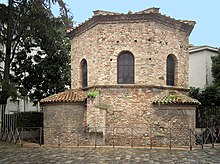| Ravenna | |
 | |
| Information | |
| Country | Italy |
| Region | Emilia-Romagna |
| Surface | 652 km² |
| Population | 158 800 |
| Area code | 39 0544 |
| Postal Code | 48121–48125 |
| website | |
Ravenna (in Italian Ravenna) - a city in the north Italy, known as city of mosaics, because of the unique antique mosaics from the 5th and 6th centuries from the early Christian period and because it is also known today for the production of mosaics. In Ravenna, we find 8 sites inscribed by UNESCO on World Cultural Heritage ListBut that's not all, the city also offers tourists many interesting cultural events, and the Old Town of Ravenna is a perfect place for walking.
General information
Ravenna is located in the region Emilia-Romagnajust 10 km from the Adriatic coast. It is the capital Ravenna Province and has about 150 thousand. residents.
Drive
By plane
There are three airports in the vicinity of Ravenna: Forlì (30 km), Rimini (50 km) i Bologna (80 km).
Forli airport mainly serves low-cost airlines and has connections with some countries of Eastern Europe.
Rimini airport nearby (ICAO: RMI) supports both local (Rome, Palermo and Catania) and international connections.
Another airport in this region is Bologna (ICAO: BLQ), one of the most important in Italy. Supports connections with Poland: Katowice, Cracow (Ryanair) and many other countries around the world, plus domestic flights to the following destinations: Alghero, Bari, Brindisi, Cagliari, Catania, Lamezia Terme, Milano (Malpensa), Naples, Olbia, Palermo, Reggio Calabria, and Rome ( Fiumicino).
By rail
There is a train station in Ravenna. It has a direct rail connection from Bologna, Rimini, Ferrara, Rome, Parma.
By car
A branch of the A14 motorway leaves for Ravenna Bologna-Rimini. In addition, the roads intersect here towards Ferrara, Rimini, Cesena, Chioggia, Forl and Faenza.
By bus
By ship
Communication
Ravenna, like the entire Emilia-Romagna region, is covered by one ticket fare.
Worth seeing



The city is known for its numerous monuments from the early Christian period. The numerous mosaics decorating the ancient buildings in Ravenna are especially valuable. In 1996, eight monuments were placed on the UNESCO World Heritage List (the Mausoleum of Galli Placidia, the Orthodox Baptistery, Sant'Apollinare Nuovo, the Arian Baptistery, the Archbishop's Chapel, the Mausoleum of Theodoric, San Vitale, and Sant'Angelo 'Apollinare in Classe).
They come primarily from the fifth century, when the West Roman court stayed in Ravenna the mausoleum of Gallia Placidia and Orthodox Baptistery, also called from the name of the bishop who completed its construction, Neon's Baptisteryas well as the Basilica of San Giovanni Evangelista, Basilica Ursiana and other religious buildings. From the second half of the 5th century and the first half of the 6th century, when the city was ruled by Theodoric, the Arian cathedral (Santo Spirito, from the end of the 5th century), churches: Sant'Apollinare Nuovo, Sant'Apollinare in Classe and San Vitale, the Arian Baptistery and Theodoric's mausoleum. From the time of Justinian, when Ravenna was the capital of the exarchate, the churches of Sant'Apollinare in Classe and San Vitale were completed; some other monuments have been rebuilt.
The monuments from more recent times include buildings such as: the town hall from the 15th and 17th centuries, 18th-century palaces, a tomb and the Dante Museum.
The most important monuments:
- Basilica Ursiana
- The Mausoleum of Gallia Placidia - located near the Basilica of San Vitale. There are exceptionally beautiful and valuable mosaics in the mausoleum, which are preserved in very good condition. You can only enter in small groups and only for 5 minutes, so as not to harm the microclimate of the interior.
- Orthodox Baptistery - an important monument built in the middle of the 5th century before the conquest of Ravenna by Byzantium.
- Church of San Vitale - one of the most famous monuments of Ravenna and the most important Byzantine buildings in Western Europe. Initially, the construction was carried out by Theodoric, and later continued by Justinian. It is an octagonal building on a central plan, covered with a dome, with 8 niches adjacent to the nave. This temple combines the distinctive features of Eastern and Western architectural styles. The decorations inside the building are particularly delightful - mosaics and frescoes, showing, among others, scenes from the Old and New Testaments. The numerous mosaics present the Emperor Justinian and his wife Theodora surrounded by the court and in full royal power, with splendor and wealth.
- Theodoric's mausoleum - cost 4/2 €
- Basilica of Sant'Apollinare in Classe
- Basilica of Sant'Apollinare Nuovo
- Arian Baptistery (Battistero degli Ariani) - Vicolo degli Ariani, located approx. 200 m from Piazza del Popolo; there may be a problem with parking in the immediate vicinity; open daily 8: 30-16: 30; tel. 39 0544 543711
The cost of visiting all buildings related to early Christian mosaics is 9.5 €. It is valid for 7 days (one entry to the site).
Nearest neighborhood
On the Adriatic: Lido Adriano, Lido di Dante and Marina di Ravenna.
work
Science
Shopping
Gastronomy
Festivals, parties
Accommodation
contact
Security
Tourist information
Where next
- Bologna - the capital of the Emilia-Romagna region
- Ferrara
- Rimini
- Padua
- San Marino - a tiny republic, an enclave in the territory of Italy
| This is outline article. For now, it includes the article schema and not much else. You can help by supplementing the article with at least basic information, making it useful. |

